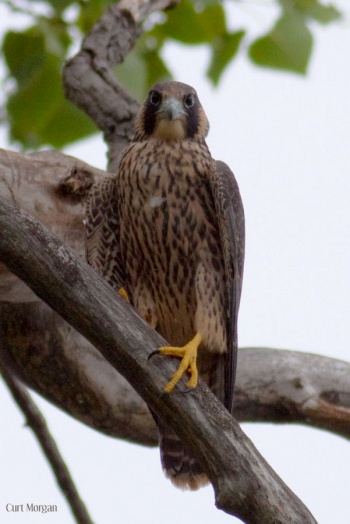| Line 2: | Line 2: | ||
'''Includes Cape Verde Peregrine Falcon''' | '''Includes Cape Verde Peregrine Falcon''' | ||
;[[:Category:Falco|Falco]] peregrinus | ;[[:Category:Falco|Falco]] peregrinus | ||
| − | + | ||
==Identification== | ==Identification== | ||
L. 15–21 in | L. 15–21 in | ||
Revision as of 14:54, 24 June 2012
Includes Cape Verde Peregrine Falcon
- Falco peregrinus
Identification
L. 15–21 in
- Thick, dark moustachial stripe
- Sides of neck white
- Hooked blue/gray bill
Adult Slate grey above (female rather browner), buff barred darker below. Cere, legs and area around the eyes is yellow
Juvenile: dark brown above , streaked below
Distribution
Almost worldwide. In North America breeds in Alaska, northern and western Canada and western coastal Greenland.
Taxonomy
17 races are recognised: In North America F. p. anatum breeds across much of the continent, pealei on the Pacific coast and tundrius in the far north. Race cassini breeds in southern South America. The nominate race peregrinus breeds over Europe and western Asia, calidus in Siberia and japonensis in eastern Asia. F. p. brookei breeds around the Mediterranean and peregrinator from India to southern China. The tropical African race is minor, madens breeds on the Cape Verde Islands and radama in Madagascar and the Comoros. F. p. ernesti breeds in the Philippines, Indonesia and New Guinea, nesiotis in Vanuatu, the Loyalty Islands and New Caledonia, furuitii on Volcano Island, macropus in Australia and submelanogenys in south-west Australia.
Habitat
Cliff-faces for breeding, hunts over cultivated land and grassland, marshes and wetlands, beaches and the sea. Also increasingly using urban areas to nest/breed on buildings.
Behaviour
Flight
Takes prey on ground and in the air using height advantage to gain speed. Often employs a high speed steep dive where reported speeds exceed 200kph. The impact of this dive can kill prey outright. Also pursues prey such as Feral Pigeon/Rock Dove in flight using speed from a dive and rapid jinking manoeuvering.
Diet
The diet includes birds, such as doves, waterfowl and songbirds, occasionally hunt small mammals, including bats, rats, voles and rabbits. Insects and reptiles make up a relatively small proportion of their diet. Peregrine Falcons also eat their own chicks when starving.
Breeding
A scrape on a cliff ledge is made and 3-4 eggs are laid. The females incubate the eggs for 29-32 days. Chicks fledge 35-42 days after hatching. Is increasingly being reported using urban high-rise buildings and churches for nest/breeding sites to prey on Feral Pigeon.
Vocalisation
<flashmp3>Falco peregrinus (song).mp3</flashmp3>
Listen in an external program
References
- Collins Pocket Guide to British Birds 1966
External Links
Specie Profile Peregrine Falcon (Falco peregrinus) - AVIS-IBIS





